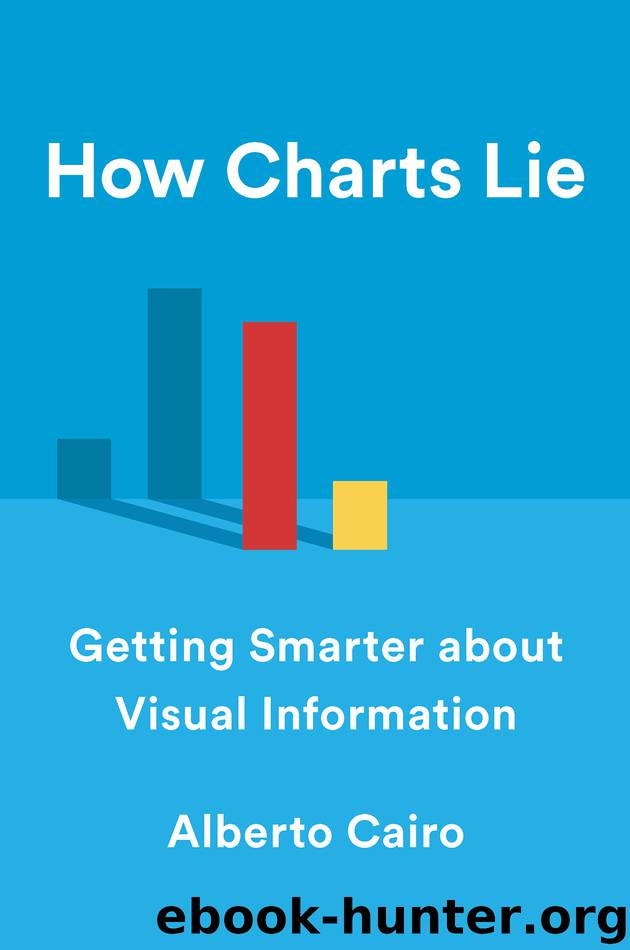How Charts Lie by Alberto Cairo

Author:Alberto Cairo
Language: eng
Format: epub
Publisher: W. W. Norton & Company
Published: 2019-09-12T16:00:00+00:00
When it comes to designing a chart, which values are better, nominal (nonadjusted) or real (adjusted)? It depends. Sometimes, adjusted values matter much more. Comparing box offices or any other kind of price, cost, or salary over time doesn’t make sense if you don’t adjust your figures, as we’ve just seen. To understand a nominator, you need to pay attention to the denominator, particularly if you make comparisons between groups that have different denominators.
Imagine that I give you two slices from one pizza and I give another person three slices from a different pizza. Am I being mean to you? It depends on how many slices each of the pizzas is divided into:
Not taking denominators into account can have grave consequences. Here’s a bar graph inspired by fictional data provided by Judea Pearl in his The Book of Why: The New Science of Cause and Effect:
Pearl’s fictional data reflects numbers thrown around during heated debates in the 19th century, when the smallpox vaccine became widespread, between those in favor of universal inoculation and those opposed. The latter were worried because the vaccine caused reactions in some children and those reactions sometimes led to deaths.
As alarming as it looks (“More children died because of the vaccine!”), the chart I designed isn’t enough to help you make a decision about whether to vaccinate your own children. For it to tell the truth, I need it to display much more data, including the denominators. This flow and bubble chart can make us smarter at reasoning about this case:
Let’s verbalize what the chart reveals: 99% of children out of my fictional population of 1 million took the vaccine. The probability of having a reaction is roughly 1% (that’s 9,900 out of 1 million). The probability of dying if you have a reaction is also 1% (99 out of 9,900). But the probability of dying because of the vaccine is just 0.01% (99 out of 990,000 who were inoculated).
On the other hand, if you don’t take the vaccine, there’s a 2% probability of getting smallpox (200 out of 10,000). And if you do get the disease, there’s a 20% chance that you’ll die (40 out of 200). The reason why my first chart shows that many more children died because of a reaction to the vaccine than because of smallpox itself is simply that the population that took the vaccine (990,000) is enormously larger than the population of children who didn’t (10,000), a fact that I should have disclosed.
I agree that 99 versus 40 still looks like a huge difference, but try to reason with a hypothetical. Imagine that no children were inoculated against smallpox. We know that 2% will get the disease. That’s 20,000 children out of a population of 1 million. Of those, 20% will die: 4,000 in total. Here’s my updated chart:
The 139 there is the result of adding the 40 kids who weren’t vaccinated and died of smallpox and the 99 who were vaccinated and died after a reaction to the vaccine.
Download
This site does not store any files on its server. We only index and link to content provided by other sites. Please contact the content providers to delete copyright contents if any and email us, we'll remove relevant links or contents immediately.
| Biomathematics | Differential Equations |
| Game Theory | Graph Theory |
| Linear Programming | Probability & Statistics |
| Statistics | Stochastic Modeling |
| Vector Analysis |
Modelling of Convective Heat and Mass Transfer in Rotating Flows by Igor V. Shevchuk(6406)
Weapons of Math Destruction by Cathy O'Neil(6215)
Factfulness: Ten Reasons We're Wrong About the World – and Why Things Are Better Than You Think by Hans Rosling(4713)
A Mind For Numbers: How to Excel at Math and Science (Even If You Flunked Algebra) by Barbara Oakley(3256)
Descartes' Error by Antonio Damasio(3248)
Factfulness_Ten Reasons We're Wrong About the World_and Why Things Are Better Than You Think by Hans Rosling(3216)
TCP IP by Todd Lammle(3155)
Fooled by Randomness: The Hidden Role of Chance in Life and in the Markets by Nassim Nicholas Taleb(3080)
Applied Predictive Modeling by Max Kuhn & Kjell Johnson(3041)
The Tyranny of Metrics by Jerry Z. Muller(3028)
The Book of Numbers by Peter Bentley(2931)
The Great Unknown by Marcus du Sautoy(2662)
Once Upon an Algorithm by Martin Erwig(2622)
Easy Algebra Step-by-Step by Sandra Luna McCune(2604)
Lady Luck by Kristen Ashley(2554)
Police Exams Prep 2018-2019 by Kaplan Test Prep(2516)
Practical Guide To Principal Component Methods in R (Multivariate Analysis Book 2) by Alboukadel Kassambara(2513)
All Things Reconsidered by Bill Thompson III(2371)
Linear Time-Invariant Systems, Behaviors and Modules by Ulrich Oberst & Martin Scheicher & Ingrid Scheicher(2346)
